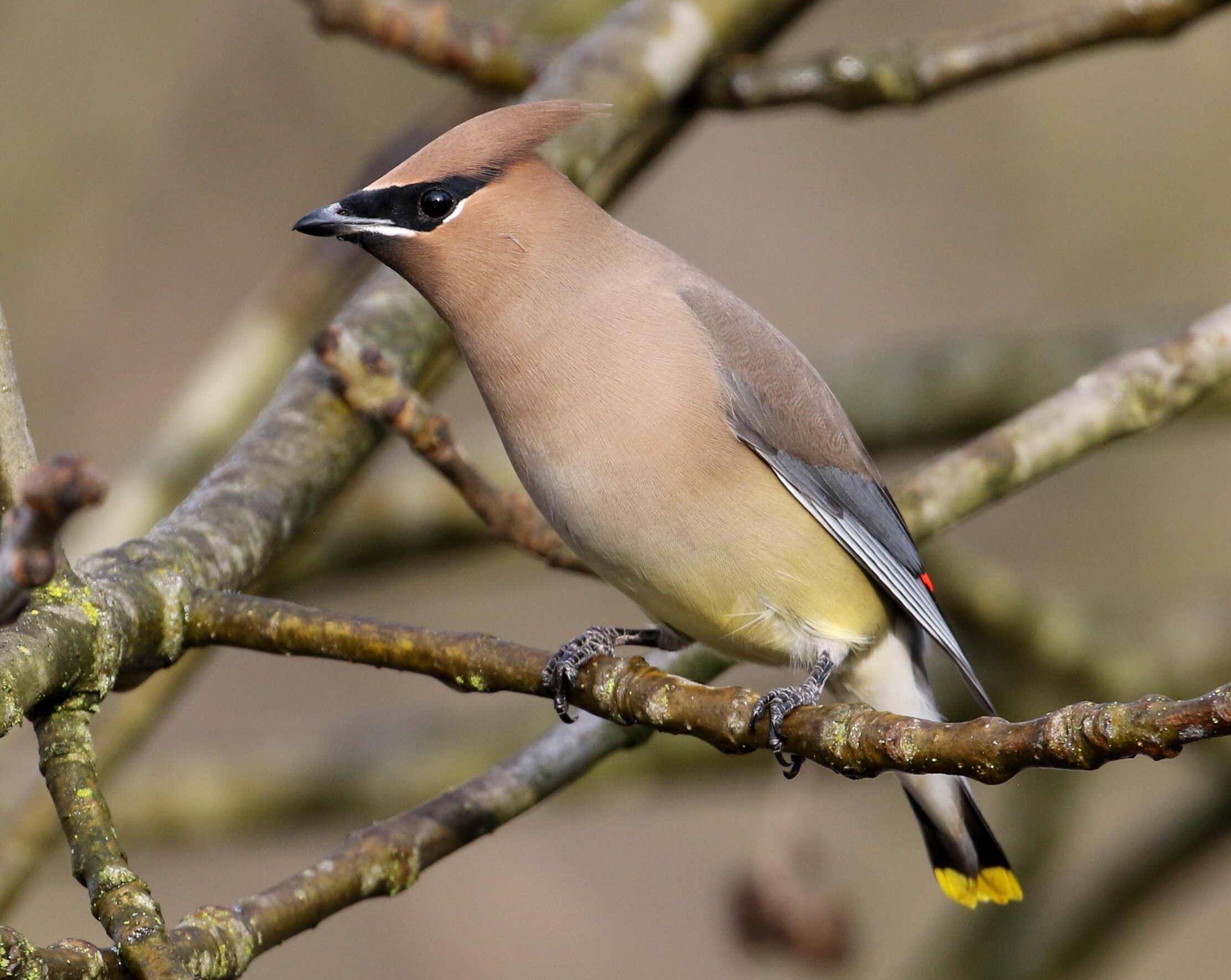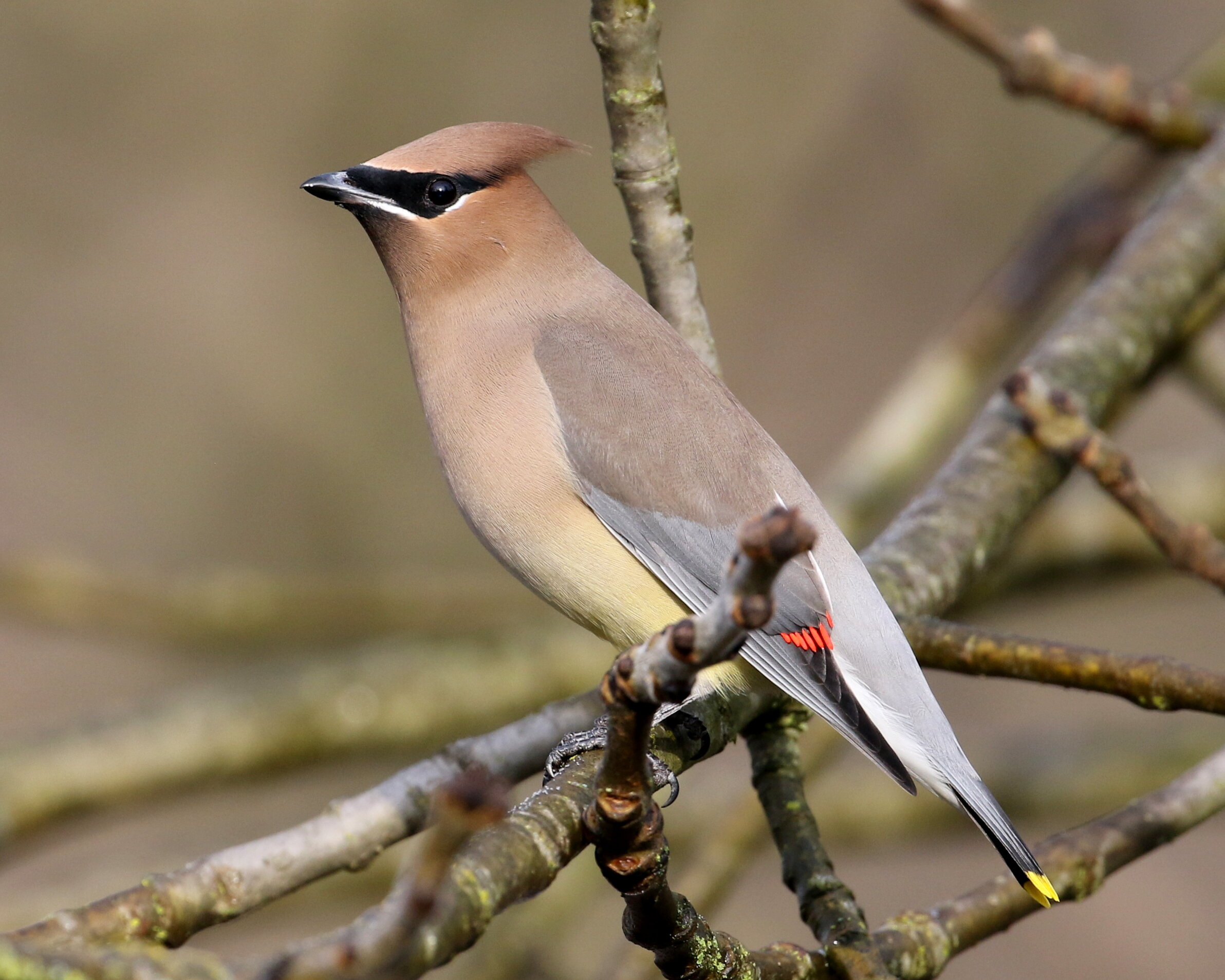Cedar Waxwing, Image by Ray Rozema
Cedar Waxwings are delightful birds and fairly common here in the Sacramento Valley. Most of the time, they fly in flocks and often show up in our yards. Cedar Waxwings are very social birds. There have been several reports of waxwings seen passing berries, one-by-one, down a row of birds! By using this technique, several birds obtained food that was difficult to reach.
In the summer, Cedar Waxwings nest all across Canada and in the northern most states. But in fall and winter, many fly south in large flocks into the central and southern parts of the U.S. They can fly as far south as Central America and the northern part of South America. Cedar Waxwings do not have set migration routes. They fly in search of food, wherever it takes them.
What does a Cedar Waxwing look like?
Cedar Waxwings are a treat to see because they are very unique-looking. Both males and females look alike. Adult birds have a group of pointed feathers on top of their heads, which is called a crest. A bold black color covers their eyes and faces and resembles a mask. They have pale yellow abdomens, gray upper tail and wing areas, brown heads, chests, and necks, and have bright yellow band on the tip of their otherwise dark tails. Young birds also have these yellow tail tips; but they look different from their parents. They have streaky bodies and do not have dark masks (or only have faintly colored masks). Often on Cedar Waxwings, you can see a wax-like red (or orange) substance on the tips of a particular set of flight feathers. This unusual and brightly-colored substance on their wings is why they are called waxwings. The color is related to the kind of berries the Waxwing has been eating!
Cedar Waxwing, Image by Chris Conard
What does the Cedar Waxwing eat?
Cedar Waxwings love berries and can remain healthy by eating only berries for several months of the year. Most other bird species need a more varied diet. Cedar Waxwings move around from location to location in search of berries and eat the berries by swallowing them whole! Waxwings have the anatomy to do this; humans do not, so please don’t try this yourself. Cedar Waxwings also enjoy other fruits, including apples and cherries, and they eat insects and cedar cones too.
Cedar Waxwings, Image by Larry Hickey
How do Cedar Waxwings make their nests?
Even though a pair will search for a nest site together, it's the female Cedar Waxwing that makes the final decision on where the nest will be constructed. The nest site is usually in a fork or “v” of two branches. The nest is woven with twigs, grasses, cattail down, blossoms, string, and horsehair, and many other materials. Imagine this….. it takes more than 2,500 trips to the nest and 5-6 days before the nest is finally completed! It is also common to see several nests, or colonies, fairly close together in the same tree. This species is truly quite social and cooperative with one another. You can see a picture of a Cedar Waxwing on her nest at the USGS website.
What do Cedar Waxwings sound like?
Even though they are classified as songbirds, Cedar Waxwings do not have a song! They only make a few call notes. Their calls are generally heard when they are flying and have been described as a thin, high-pitched whistle or trill. Because Cedar Waxwings usually fly in flocks, you often hear lots of them calling together. Two terms have been given for a flock of Cedar Waxwings. One is an “ear-full.” You may come to understand the first term, “ear-full,” after listening to them. You can click on the box below to listen now. The second term for a flock of Cedar Waxwings is a “museum.” Perhaps this is because they are such attractive-looking birds. What do you think?
This recording of the Cedar Waxwing is from xeno-canto. More Cedar Waxwing vocalizations can be found at xeno-canto.org/species/Bombycilla-cedrorum.
So if you have never noticed or seen Cedar Waxwings, hopefully you will sometime soon. Listen for their calls and then look high in the trees around you. Perhaps they are perched there enjoying a fabulous meal.





